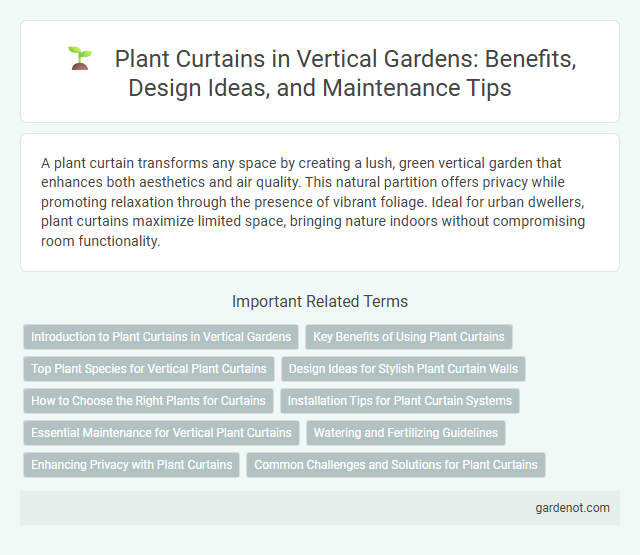A plant curtain transforms any space by creating a lush, green vertical garden that enhances both aesthetics and air quality. This natural partition offers privacy while promoting relaxation through the presence of vibrant foliage. Ideal for urban dwellers, plant curtains maximize limited space, bringing nature indoors without compromising room functionality.
Introduction to Plant Curtains in Vertical Gardens
Plant curtains in vertical gardens serve as living walls made from dense foliage panels that create natural privacy screens and enhance aesthetic appeal. These curtains use trailing and climbing plants such as ivy, philodendron, or pothos, which thrive in vertical systems and maximize green coverage. Integrating plant curtains improves air quality, reduces noise pollution, and offers sustainable urban greenery solutions especially in limited space environments.
Key Benefits of Using Plant Curtains
Plant curtains enhance vertical gardens by improving indoor air quality through natural filtration of pollutants and toxins. They provide excellent thermal insulation, reducing energy costs by maintaining indoor temperatures. Additionally, plant curtains promote privacy while adding aesthetic value with lush greenery, creating a calming and visually appealing environment.
Top Plant Species for Vertical Plant Curtains
Top plant species for vertical plant curtains include ferns like Boston fern (Nephrolepis exaltata), English ivy (Hedera helix), and pothos (Epipremnum aureum) due to their dense foliage and adaptability to vertical growth. Succulents such as string of pearls (Senecio rowleyanus) and sedum varieties offer drought tolerance and unique textures for dynamic visual appeal. Flowering plants like begonias and impatiens provide vibrant color contrasts, making vertical plant curtains both functional and decorative in indoor and outdoor spaces.
Design Ideas for Stylish Plant Curtain Walls
Plant curtain walls transform vertical spaces into lush green statements, combining aesthetics with natural air purification. Optimal design ideas include layering diverse foliage textures and colors to create dynamic visual depth, while integrating modular planters for easy maintenance and flexibility. Incorporating LED grow lights and automated irrigation systems enhances plant health and sustains the striking appearance of these stylish vertical gardens.
How to Choose the Right Plants for Curtains
Selecting the ideal plants for vertical garden curtains depends on light availability, humidity levels, and maintenance preferences. Opt for trailing species like pothos, English ivy, or philodendrons that naturally drape and create a lush, cascading effect. Ensure plants have similar water and light requirements to maintain uniform health and vibrant growth on your plant curtain.
Installation Tips for Plant Curtain Systems
Plant curtain systems require secure mounting on sturdy frameworks such as walls or metal grids to support the weight of plants and soil. Use moisture-resistant materials and install proper drainage systems to prevent water damage and ensure healthy root growth. Regular maintenance access should be considered during installation for watering, pruning, and plant replacement.
Essential Maintenance for Vertical Plant Curtains
Vertical plant curtains require regular watering and monitoring to maintain optimal moisture levels without over-saturating the roots. Pruning dead or overgrown foliage ensures healthy growth and preserves the aesthetic appeal of the plant curtain. Nutrient supplementation with balanced fertilizers supports sustained vitality and enhances photosynthesis efficiency in vertical garden installations.
Watering and Fertilizing Guidelines
Plant curtains require consistent watering to maintain moisture without over-saturating the root zone, ideally using a drip irrigation system for controlled hydration. Fertilize with a balanced, water-soluble fertilizer every 4 to 6 weeks during the growing season to support healthy foliage and root development. Monitoring soil moisture and adjusting watering frequency based on seasonal changes prevents nutrient leaching and promotes optimal plant growth.
Enhancing Privacy with Plant Curtains
Plant curtains serve as an innovative vertical garden solution that enhances privacy by creating dense, natural barriers with lush foliage. These living walls effectively block sightlines while promoting improved air quality and aesthetic appeal in urban and residential spaces. Integrating climbers like ivy, pothos, or philodendrons ensures year-round coverage and adds a vibrant, eco-friendly dimension to privacy screens.
Common Challenges and Solutions for Plant Curtains
Plant curtains often face challenges such as inconsistent watering, inadequate sunlight, and pest infestations that can hinder their growth. Implementing automated drip irrigation systems ensures uniform moisture distribution, while selecting shade-tolerant plants and positioning the curtain strategically maximizes light exposure. Regular maintenance including pruning, pest control with natural predators, and using disease-resistant plant varieties helps sustain healthy, vibrant vertical greenery.
Plant curtain Infographic

 gardenot.com
gardenot.com